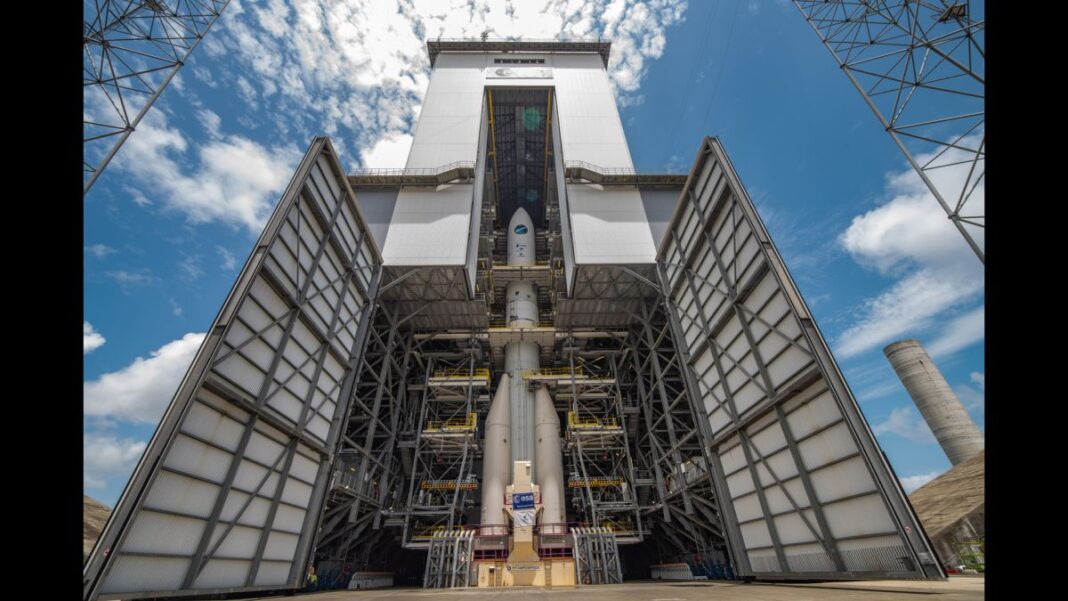Europe’s heavy-lift Ariane 6 rocket, in development since the early 2010s, will not fly before the end of 2023, European Space Agency (ESA) officials said in a news conference on Thursday (Oct. 20), adding that the delay will add another 600 million euros to the rocket’s already mighty price tag.
The setbacks, however, don’t deter the European space industry from bold visions of future space transportation that include a reusable second stage for Ariane 6 and a homegrown astronaut transportation capability.
The debut flight of Ariane 6, which will replace Europe’s reliable workhorse Ariane 5 that famously launched the James Webb Space Telescope on Christmas Day 2021, was originally planned for 2020 but has slipped several times since.
The rocket features a reignitable upper stage called Vinci (opens in new tab) that can deliver satellites to various orbits and altitudes and which, after completing its assignment, deorbits autonomously and burns up in Earth’s atmosphere.
Related: Europe’s reusable ‘Susie’ spacecraft could launch astronauts on future deep-space missions
The latest delay was caused by several factors, including the introduction of a new power unit and delays in testing and in the development of robotic arms that assist on the launch pad during rocket fueling, Daniel Neuenschwander, ESA’s director of space transportation, said in the press conference.
The slipping schedule will add another 600 million euros to the development cost of the rocket, which has already amounted to a little under 4 billion euros, Neuenschwander said.
Speaking at the same conference, ESA director general Josef Aschbacher admitted that further delays are possible, as three major milestones have to be completed in the first quarter of 2023 for Ariane 6 to receive a “go” for liftoff later that year.
The milestones in question include the conclusion of hot firing tests of the Vinci upper stage that recently commenced in Germany and a hot firing test of Ariane 6’s core stage, which will be conducted at Europe’s Spaceport in Kourou, French Guiana. The core features an upgrade of the Vulcain engine previously used on Ariane 5. ESA and its industry partners would also have to begin the launch system qualification review of the new rocket by the first quarter of 2023 to meet the new launch target.
Despite the setbacks, the French company Arianespace, which operates the Kourou spaceport and sells launches from the site, sees increasing demand for Ariane 6’s services in the coming decade.
“Competition is increasing, but the good news is that the market is also increasing,” Stéphane Israël, Arianespace chief executive, said in the same news conference. “We see an accessible market for Ariane 6 and [the lightweight rocket] Vega to be 4 billion euro per year this decade, as opposed to 2 billion during the 2010 to 2020 decade.”
Israël added the company has already sold 29 Ariane 6 launches.
“It’s a very strong order book for a launcher that’s not flown yet,” he said.
Earlier this year, Arianespace signed a launch contract with Amazon’s megaconstellation project Kuiper to deploy a major portion of Kuiper satellites using 18 Ariane 6 rockets.
Ariane 6 is manufactured by ArianeGroup, a joint venture between European aerospace giants Airbus and Safran, in production facilities in France and Germany.
Ariane 6 is an expendable launch vehicle with no reusable components. However, the partners are looking into future reusable upgrades, including a methane-powered engine called Prometheus that would form a backbone of a new reusable first stage called Themis.
Neuenschwander said ESA is already looking at future “technology disruptors and rapid demonstrators” including a reusable second stage, which will be discussed with ESA member states at the upcoming ministerial conference in Paris in November.
“We consider that this is of utmost importance to show that we are technically capable of doing that in Europe,” Neuenschwander said.
ESA, which currently flies its astronauts to the International Space Station aboard American (and previously Russian) vehicles, also has aspirations for its own independent means of astronaut transportation.
“We want to propose preparatory activities for European human space transportation capabilities [at the upcoming ministerial] in order to prepare an informed decision by member states as of 2023,” Neuenschwander said.
Earlier this year, Europe successfully flew Vega C, a new version of its lightweight Vega rocket. Arianespace previously sold launches on Russia’s Soyuz rocket from the Kourou spaceport; however, this cooperation ceased following Russia’s invasion of Ukraine.
Follow Tereza Pultarova on Twitter @TerezaPultarova. Follow us on Twitter @Spacedotcom and on Facebook.


